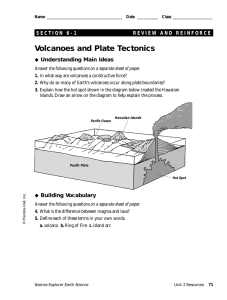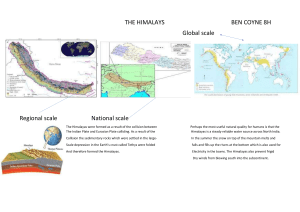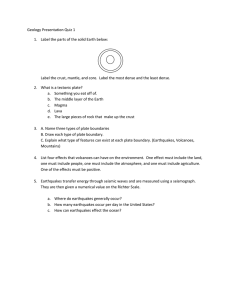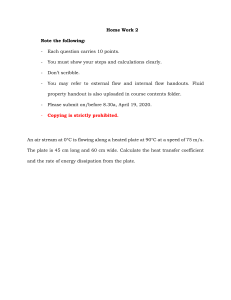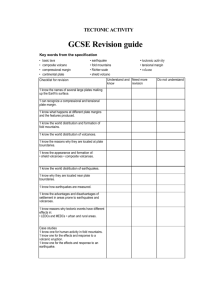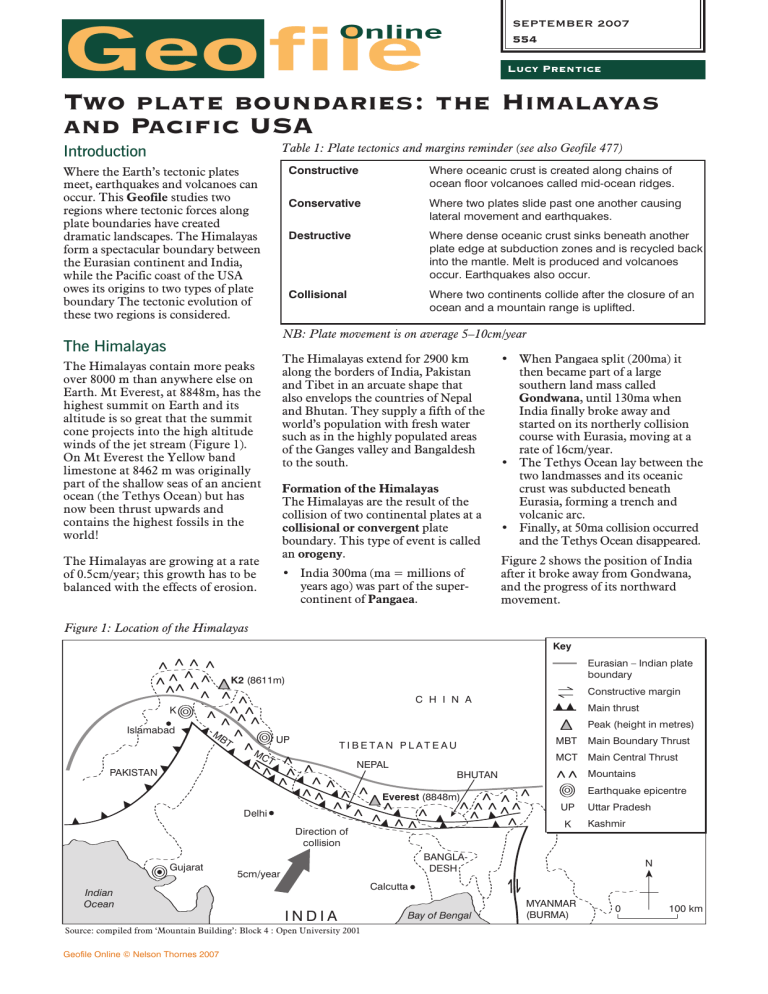
SEPTEMBER 2007 554 Online Geo file Lucy Prentice Two plate boundaries: the Himalayas and Pacific USA Table 1: Plate tectonics and margins reminder (see also Geofile 477) Introduction Where the Earth’s tectonic plates meet, earthquakes and volcanoes can occur. This Geofile studies two regions where tectonic forces along plate boundaries have created dramatic landscapes. The Himalayas form a spectacular boundary between the Eurasian continent and India, while the Pacific coast of the USA owes its origins to two types of plate boundary The tectonic evolution of these two regions is considered. Constructive Where oceanic crust is created along chains of ocean floor volcanoes called mid-ocean ridges. Conservative Where two plates slide past one another causing lateral movement and earthquakes. Destructive Where dense oceanic crust sinks beneath another plate edge at subduction zones and is recycled back into the mantle. Melt is produced and volcanoes occur. Earthquakes also occur. Collisional Where two continents collide after the closure of an ocean and a mountain range is uplifted. NB: Plate movement is on average 5–10cm/year The Himalayas The Himalayas extend for 2900 km along the borders of India, Pakistan and Tibet in an arcuate shape that also envelops the countries of Nepal and Bhutan. They supply a fifth of the world’s population with fresh water such as in the highly populated areas of the Ganges valley and Bangaldesh to the south. The Himalayas contain more peaks over 8000 m than anywhere else on Earth. Mt Everest, at 8848m, has the highest summit on Earth and its altitude is so great that the summit cone projects into the high altitude winds of the jet stream (Figure 1). On Mt Everest the Yellow band limestone at 8462 m was originally part of the shallow seas of an ancient ocean (the Tethys Ocean) but has now been thrust upwards and contains the highest fossils in the world! Formation of the Himalayas The Himalayas are the result of the collision of two continental plates at a collisional or convergent plate boundary. This type of event is called an orogeny. The Himalayas are growing at a rate of 0.5cm/year; this growth has to be balanced with the effects of erosion. • India 300ma (ma = millions of years ago) was part of the supercontinent of Pangaea. • When Pangaea split (200ma) it then became part of a large southern land mass called Gondwana, until 130ma when India finally broke away and started on its northerly collision course with Eurasia, moving at a rate of 16cm/year. • The Tethys Ocean lay between the two landmasses and its oceanic crust was subducted beneath Eurasia, forming a trench and volcanic arc. • Finally, at 50ma collision occurred and the Tethys Ocean disappeared. Figure 2 shows the position of India after it broke away from Gondwana, and the progress of its northward movement. Figure 1: Location of the Himalayas Key Eurasian – Indian plate boundary K2 (8611m) Constructive margin C H I N A Main thrust K Islamabad Peak (height in metres) M BT UP MBT TIBETAN PLATEAU MC T MCT Main Central Thrust NEPAL PAKISTAN Mountains BHUTAN Earthquake epicentre Everest (8848m) UP Delhi K Direction of collision Gujarat Main Boundary Thrust Uttar Pradesh Kashmir BANGLADESH 5cm/year N Calcutta Indian Ocean INDIA Bay of Bengal Source: compiled from ‘Mountain Building’: Block 4 : Open University 2001 Geofile Online © Nelson Thornes 2007 GeoFile Series 26 Issue 1 Fig 554_01 Mac/eps/illustrator 11 s/s MYANMAR (BURMA) 0 100 km September 2007 no.554 Two plate boundaries: the Himalayas and Pacific USA Figure 2: Position of India 100 ma after break-up of Gondwana and movement northwards to collision with Eurasia E u r a s i a n P l a t e Zanskar Pacific Coast of the Western USA India today 10 million years ago 38 million years ago r – 5c ms/ye ar Equator 16 cm s/yea 55 million years ago Indian (Tethys) Ocean India 71 million years ago Sri Lanka Source: Pierre Dezes, PhD thesis: ‘Tectonic and GeoFile Series 26 Issue 1 metamorphic evolution of the Central Himalayan 554_02 de s/s in South EastMac/eps/illustrator Zanskar’, Memoires11 domain Fig NELSONNo.32 THORNES Geologie Clausanne 1999 PUBLISHING Artist: David Russell Illustration Once collision occurred the Indian continental crust was unable to subduct fully as it is more buoyant than oceanic crust, this led to the Indian plate being sliced by enormous faults called thrusts which pushed the rocks and sediments of the leading edge backwards and upwards forming the Himalayas. It is largely the leading edge of the Indian subcontinent that has deformed to form the Himalayas. The Main Central Thrust (MCT) is largely responsible for the highest peaks of the Himalayas; the Main Boundary Thrust (MBT) delimits the southern edge of the foothills. The collision with India squeezed the Tibetan plateau up to an average height of 5000 m, leaving the continental crust below Tibet 70 km thick, the maximum known. India is still indenting into Eurasia at a rate of 5 cm/year. Seismic events The collision boundary between India and Eurasia is seismically very active. As the two continents push against each other, enormous pressures deep Geofile Online © Nelson Thornes 2007 down in the crust develop. Some of the largest earthquakes in recent times have occurred not in the mountains but in the lower-lying foothills or coastal plains to the south. The United States to the west of the Rocky Mountains owes its topography to tectonic processes which have compressed, sliced and erupted through the North American continent. The United States Pacific coastline (excluding Alaska and Hawaii) extends from the border with Mexico in the south 6800 miles along the Pacific Ocean to the Canadian border. There are two types of plate boundary present: conservative and destructive. Within California a conservative or strike-slip fault (the San Andreas Fault) is the dominant tectonic feature whereas through Oregon and Washington State it is a destructive margin or subduction zone which is responsible for the volcanic landscapes of the Cascade volcanoes. Tectonic evolution The original coastal margin of the North American continent was near Notable earthquakes (see Figure 1): Uttar Predesh 1999 • 29 March 1999 • 6.8 Richter scale • 185 miles north-east of New Delhi near India’s border with China • The earthquake was caused by a sudden release of energy along a thrust within the Himalayan foothills. Gujurat 2001 • 25 January 2001 • 7.7 Richter scale • Coastal area of Gujarat near the border between Pakistan and India • Estimates say 30,000 people died. Kashmir 2005 • 5 October 2005 • 7.6 Richter scale • Indian/Pakistan border region of Kashmir • 75,000 people died as a direct result of the quake • 3.3 million were left homeless. • Recovery from the quake was impeded by the remote and difficult terrain at the beginning of the winter snowfall. to the western boundary of the present-day Rocky Mountains. As the continent was pushed westwards by the widening Atlantic Ocean, the margin with the Pacific plate became active/destructive/compressional, and mini-continents or groups of islands were accreted onto the western margin of the continent as the Pacific Ocean floor was subducted. These are called accretionary terranes and became part of the lithosphere of the North American continent. Hence the western coast of the USA was built out towards the west. The Sierra Nevada mountains are the granitic roots of an old chain of volcanoes formed as the Pacific plate subducted beneath present-day California about 125–82ma. Yosemite National Park is in the Sierra Nevada Range and is famous for its large granitic mountains, e.g. Half-Dome. Present day Subduction now only occurs where the last remnant of oceanic crust to the east of the spreading ridge, the Juan da Fuca plate, is still being subducted beneath Northern California, Oregon and Washington forming the Cascade range or arc of volcanoes, including Mt St Helens (Figure 3).Eventually as the spreading margin is subducted then the active volcanoes of the Cascade Range will become fewer as magma generation, caused by subduction, stops. Eventually the margin will become a conservative margin as it is in California. Just offshore from Cape Mendocino is a triple junction where the Pacific plate, the southern Juan da Fuca plate (Gorda plate) and the North American plate meet. It is one of the most earthquake-prone areas in North America. The volcanoes of the Cascades The volcanoes of the High Cascades are part of the Pacific ‘Ring of Fire’ and extend from Lytton Mountain (2049 m) in Canada to Lassen Peak (3189 m) in California. In the last 4000 years, 13 of the Cascade volcanoes have erupted. • Lassen Peak, in California, erupted in 1914/1921 and is one of the world’s largest lava dome volcanoes, which has grown by extrusion of a highly viscous lava called dacite rather than by explosive eruption. • In 1980 Mt St Helens produced a catastrophic lateral blast, and the volcano is still producing smaller September 2007 no.554 Two plate boundaries: the Himalayas and Pacific USA Figure 3: Plate setting of western North America ALASKA Ale O C K Y M O U N T Ca sca de S Cape Mendocino Mt St Helens (1980) Crater Lake Lassen Peak San Francisco (1906, 1989) IN s A Geofile Online © Nelson Thornes 2007 CANADA Mt Rainier rra Sie ada v Ne F SA The earthquakes of the San Andreas Fault system California is one of the most seismically active regions of the world and has approximately 10,000 earthquakes a year, of which around 20 are above magnitude 4 on the Richter scale. The San Andreas Fault system, along which the earthquakes occur, is 800 miles long and extends into the Earth’s crust for over 16 km, and has existed for 20 million years. Figure 3 shows how its trace first appears on land at Cape Mendocino then travels southwards just to the west of downtown San Francisco before cutting through Los Angeles and finally exiting land at the Gulf of California where it becomes the spreading constructive boundary of the East Pacific Rise. Tre nch Juan da Fuca Plate The greatest potential for explosive eruption in the Cascades comes from eight major strato or composite volcanoes. Five of these are in Washington State, including Mt St Helens and Mt Rainier. Strato volcanoes tend to have a central summit crater which is underlain by a network of conduits along which magma can reach the surface. Slowmoving lava flows can break out along the slopes, but this type of volcano is highly explosive due to a high silica and gas content in the magma which makes it highly viscous. The cone is composed of layers of ash, lava and rock debris from previous eruptions. The rock types are said to be of ‘intermediate’ type, which refers to their silica content of around 60–65%, and includes dacite lavas. Pyroclastic flows, heavy ashfall and lahars are the main hazards associated with this type of volcano, as illustrated by Mt St Helens in 1980. utia n N R eruptions. A lava dome is currently rebuilding the summit within the evacuated summit crater. • Mt Rainier, which at 4392 m is the highest peak in the Cascades, has the largest glaciers in the USA outside of Alaska. It is carefully monitored as it has the potential to produce disastrous lahars (volcanic mud-flows) which could reach Seattle. • Crater Lake, or Mount Mazama, appears as a flooded caldera (collapsed magma chamber) which was formed 6900 years ago in a catastrophic eruption. The small cone in the middle is called Wizard Island. USA North American Plate Los Angeles (1993) Pacific Plate 0 1000 km Key spreading ridge Gulf of California destructive margin volcano SAF San Andreas Fault mountain Gulf of Mexico East Pacific Rise Source: adapted from The Earth and its place in the Universe: Discovering Science, Open University, 1998 GeoFile Series 26 Issue 1 In Los Angeles the fault makes a The lateral movement onFig the554_03 fault is Mac/eps/illustrator 11 s/s sharp turn to the west. This has thought to be 350 miles over the last NELSON THORNES PUBLISHING compressed the crust to the north of 20 million years and is currently Artist: 0.6 David Russell Illustration the fault and has pushed up the cm/year. Very slowly the land to the Central Transverse Ranges and other west of the fault is moving northcoastal ranges. Consequently there are wards; consequently Los Angeles is number of east/west strike slip faults getting closer to San Francisco and and thrust faults to the north of LA, will one day be in Alaska! one of which caused the Northridge Earthquake in 1994. Figure 4 shows The earthquakes occur as the Pacific just some of the faults which cross the plate grinds slowly northwards relative to the North American plate; a conser- urban area of Los Angeles in addition vative or strike slip margin. This is to the San Andreas Fault. not a smooth process and the plates can The San Andreas fault is very closely become locked, when the fault finally monitored by the USGS (United breaks the energy stored is released as States Geological Survey ) and the seismic waves causing an earthquake. next ‘Big One’ is likely to occur on the southern section of the fault, which Some sections of the fault creep has not ruptured for 300 years, slowly rather than rupture and fewer affecting Los Angeles and San Diego. earthquakes occur on these sections.The impact of the earthquake Precise prediction of timings and locations of earthquakes is still not depends on how deep and how much possible and safer buildings and of the fault moves in one event. The procedures are the best protection at longer a section of the fault remains present. locked generally the larger the earthquake which is produced. September 2007 no.554 Two plate boundaries: the Himalayas and Pacific USA Conclusion Figure 4: Fault map of Los Angeles N Both the plate boundaries described are still evolving and the landscapes we see are not finalised but still under construction. Both owe in some part their formation to the oceans. The Himalayan peaks are composed of sediments from an ancient ocean. The San Andreas Fault is extending northwards as Pacific Ocean floor is destroyed and in the process causing the demise of the Cascades which owe their origin to the destruction of the Pacific Ocean plate. Palmdale Sa n Ga b Sa n rie l Ce FZ ntr al Tr a San Fernando ns ver An dr se eas F 0 20 km Z Cajon Pass Ra ng e Northridge Pasadena Santa Monica F Los Angeles Santa Monica Wh Sa n Pomona ittie rF Ju ci nt o FZ Riverside Key San Francisco: 18 April 1906 • Magnitude 7.8: shaking 48 seconds • San Andreas Fault ruptured for 296 miles • Surface displacements 6–8.5 m • Approximately 3000 dead • 300,000 people homeless from a population of 410,000 • 80% of the city destroyed by earthquake; fire was responsible for 90% of the destruction Loma Prieta (San Francisco): 17 October 1989 • Magnitude 6.9: shaking 15 seconds • Epicentre 16 km NE of Santa Cruz • Focus depth 16 km • Deaths 57 (40 on Nimitz Freeway collapse): 3757 injuries • Liquefaction in the Marina attributed to rubble from 1906 earthquake • Bay Bridge breached • $6 billion in property damage North Ridge (Los Angeles): 17 January 1994 • Magnitude: 6.7 • Epicentre 32 km NW of downtown Los Angeles in the San Fernando valley • Occured on previously unknown thrust fault (vertical displacement) • Deaths: 51; 9000 serious injuries • Permanent uplift of 50 cm of the ground surface • Major structural damage and destruction of elevated motorways Urban area Long Beach Santa Ana Fault Northridge earthquake FZ F El is no re FZ Fault zone Fault Pacific Ocean Movement Source: U.S. Geological Survey References Discovering Science, Open University, nations on plate tectonics, Himalayas, tectonic evolution of USA www.USGS.gov – United States Geological survey with daily updates and maps on earthquakes in California and around the world: Evolution of Himalayas and Western USA ‘Mountain Building’: Block 4 : Open University 2001 The Earth and its place in the Universe: up for a course. GeoFile Series 26 Issue 1 1998) (Current Open University Fig 554_04 Mac/eps/illustrator 11 can s/s be purchased direct course books www.Wikipedia.org: Online NELSON THORNES PUBLISHING from the OU without having to sign encyclopaedia with good clear explaArtist: David Russell Illustration Focus Questions 1. Create a glossary of the terms in bold by using this unit, Geofile 477 and the web resources above. 2. How can the growth of the Himalayas help to explain plate tectonic theory? (Key ideas: rifting, plate movement, subduction, collision, mountain building.) 3. How has the western coast of the USA evolved geologically over time and how will it change in the future? Draw simple sketch maps to help in your explanation. 4. Research and write a case study for: a) a Himalayan earthquake b) a Cascade volcanic eruption c) a Californian earthquake. You do not have to use the examples in the Geofile. Include a Top Ten list of facts and an explanation of these. 5. Compare the two plate margins discussed by stating in which ways they are similar and in which ways they differ. Geofile Online © Nelson Thornes 2007
